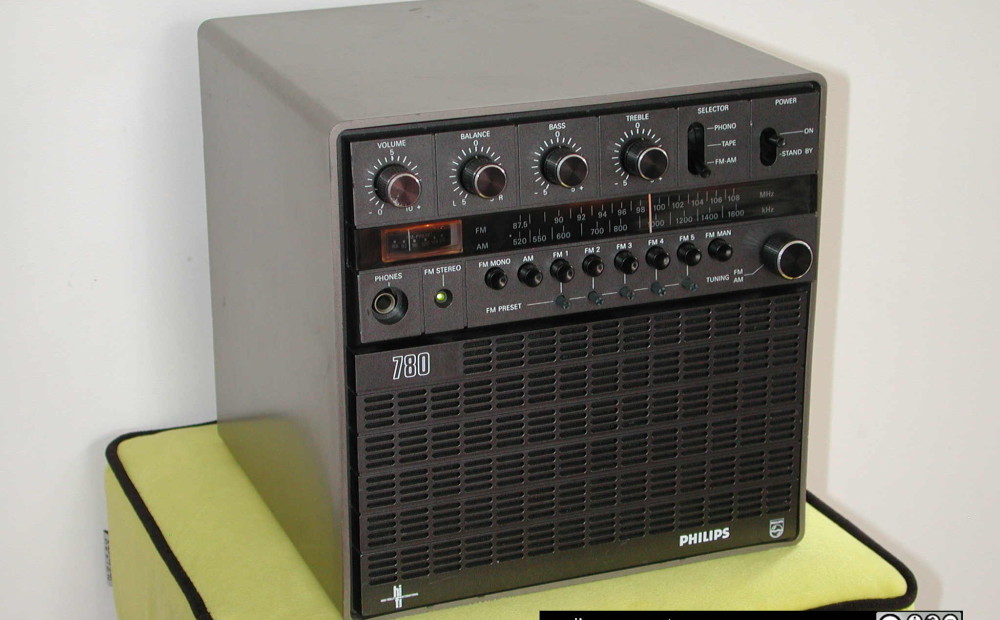And now for something completely different: a small (by 70s standards), cool cube you can put anywhere and just listen to tunes. It even has a built-in speaker!
Philips 22AH780 is a fairly small (9 x 9 x 9 inch) stereo receiver from 1978/79. It has FM/AM tuner with 5 presets for the FM, phono and tape inputs and built in speaker. Originally it was sold with additional cube speaker for stereo sound. I didn’t have the extra speaker, but luckily both the internal and the extra speaker are connected to regular DIN-type speaker sockets, so you can either use the built in speaker and the original extra speaker from the set, or connect a pair of your own speakers. At home I used modified Quadral Rondos, in our test room we even ran the thing with much more demanding Quadral Tribuns without problems.
All-plastic on the outside, but the knobs are aluminum. My unit only needed some cleaning and new dial and meter lamps. Disassembly is very simple and lamps are very easy to access, but the thing has 3 small 28V lamps, which I couldn’t find anywhere near home. They’re available in online stores, but I didn’t want to wait for delivery. So I bought 12V lamps I could get close to home, and instead of connecting them in parallel, like the old ones were, I wired them in series. They’re probably dimmer than the original lamps were, but I don’t mind.
Internally it is very nicely packed. The receiver module slides out to the front after removing 3 screws on the back. I like the idea of flat heat sink with large surface, it covers more than half of the receiver’s top. The power transformer is larger than I expected, too. Once you unscrew the heat sink, you can lift it together with the power amp section and unplug it, which gives a very easy access. The power amp section is as small as expected, but based on discrete TO-220 outputs (BD645 and BD646 pairs). With the heat sink and power amp board taken off, you can see the transformer and the preamp section. Tuner board hides below it. The built-in speaker is 2-way, ported, with a single cap before the tweeter. Nothing special, but enough for radio playing in the background.
The receiver has a 15 WPC amp with THD < 1%, at 10 WPC THD is below 0.3%. It was quite enough for fairly loud listening even with inefficient Rondos (87 dB). The Philips drives 4 ohm speakers without any issues. The sound is not extraordinary, but good, with a nice tonal balance, nice for background music – once you get used to fiddling with controls. That was my only complaint at first, I had to cut bass for low and mid level listening. The Philips has a loudness circuit that can’t be switched off, so at low settings of the volume pot it has an 8 dB bass boost. The way it works, it taps to 100k volume pot, 80k without loudness, 20k with loudness. It probably works well with the original speakers, but with better speakers there’s too much bass. So I compensated with bass pot, at -2 setting it sounded just right. This solution is not ideal, loudness circuit boosts at 100 Hz and bass control potentiometer adjusts at 50 Hz – but it’s good enough. Other than that, sound-wise it is a typical late 70s Philips (which means it sounds really pleasant, but not great). Phono stage works fine, sounds good, and it’s discrete too. I’d say it’s on par with anything you’d find in a regular integrated amp from late 70’s. FM reception is much better than I expected from this little box, actually much better than in many regular size receivers.
We did quickly compare it with a lowly but good Grundig SV 210 integrated amplifier. No surprises there, the Grundig clearly sounded better.
If you’re looking for a small-ish receiver for background/leisure listening in your office, bedroom, even kitchen maybe, and don’t mind fiddling with controls a bit to get just the right sound – I can certainly recommend this Philips. It won’t beat or even match a decent amp, but it sounds better than today’s average mini system, looks really good despite plastic finish, and in case you’ve succumbed to the recent vinyl frenzy it has a decent phono stage.
Technical information:
Amplifier:
Output power (RMS, 4 Ohms): 15W
THD: 15W: <1%, 10W: <0.3%
S/N: 60 dB
Crosstalk: 40 dB at 1 kHz
Frequency range: 35-15000 Hz +-1.5 dB
Power bandwidth: 40-25000 Hz
Balance control: 0…-20 dB
Loudness control at -30 dB: +8 dB at 100 Hz
Bass control: -11…+14 dB at 50 Hz
Treble control: -9…+12 dB at 10 kHz
Input sensitivity: 2.5 mV/47 kOhm (PHONO), 230 mV/47 kOhm (TAPE)
Output (TAPE): 0.22 mV/kOhm
Output (Speaker): 2×4 Ohms or higher
Output (Headphones): 8-600 Ohms
Tuner:
FM: 87.5 – 108 MHz
AM: 520 – 1605 kHz
Sensitivity:
mono 26 dB S/N – 1.5 uV at 40 kHz sweep
stereo 46 dB S/N – 50 uV at 40 kHz sweep
Frequency range: 35-15000 Hz
5 FM presets with frequency meter
Speaker:
Ported, 2-way, 4 Ohm
Woofer: Philips AD4060/W4 (4″, 15W, paper cone with rubber surround)
Tweeter: Philips AD2295/T4 (2″, 10W, paper cone)
Capacitor: 4.7 uF, 100V
General:
Dimensions (WHD): 23 x 23 x 22 cm / 9.1 x 9.1 x 8.7 inch



















